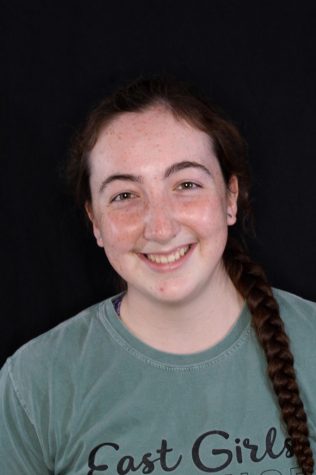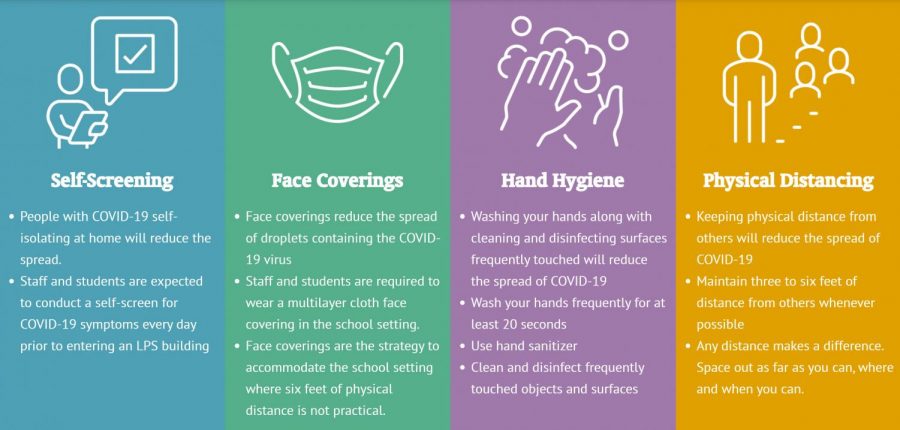Investigation: Should schools be in full remote learning right now? (Part 2)
Part 2: Staff at East explain how Covid-19 has affected their perspectives, their positions within the school
Photo by LPS
School Nurse Heather Perkins recommends that students should adhere to these four pillars of Covid-19 prevention. These things seem to be significant factors in decreasing the numbers of Covid-19 cases and deaths across the world.
When examining the question ‘Should schools be in full remote learning right now?’ there’s a number of perspectives that need to be considered. We’ve already looked at some students’ perspectives (if you didn’t see that article, check it out here), but in Part 2 of this series, I wanted to understand where staff are at with the pandemic, so I talked to a teacher, a school nurse, and a custodian to get a variety of different ideas and opinions.
Heather Perkins, a school nurse in East’s Health Office, has definitely been affected by Covid-19, as someone who is exposed to potentially sick students and staff on a daily basis, works with students, staff, and administrators to contact trace after a positive test, and answers calls from all sorts of concerned students and parents.
“Probably about 75% of my workload now is Covid-19 related,” Perkins said, “which is taking phone calls from families that either the student might be a close contact, a household contact, they might be positive, pending tests with symptoms, or they just have questions about it, you know, should their students stay home based on what’s going on in the family… Mondays are the worst – Mondays we get everything that came in over the weekend.”
However, despite how much Covid-19 has changed her job, Perkins still believes that full remote learning is not the answer. “I think what we’re doing right now is perfect,” she said. “I’m glad that we’re not 100%; I don’t think that’s appropriate, but with the 50% [capacity] and the 3/2 learning I think we’ve done a really good job. We are not seeing spread in the school, so the mitigation tactics we’re using are working.”
The 50% capacity plan has also helped a lot for her part in contact tracing. When Perkins is notified of a positive case, she works closely with the administrators and teachers at East to go through all of the student’s activities and classes in the past 48 hours. They check with the teachers to make sure there wasn’t any increased risk with distancing or masks not being worn correctly, they check to find out who the student was around at lunch and if there was a close contact there, and do the same things with any activities or athletics the student was involved in during those 48 hours.
Since students are on zoom learning about half the time, instead of in person and in contact with others at East, if someone wasn’t at school in the 48 hours before they tested positive, Perkins doesn’t have to contact trace at school. The same thing applies to weekends – if someone tested positive on a Monday, the contact tracing piece doesn’t apply. This makes Perkins’ job a lot simpler.
Fortunately, the health office has not had staffing issues. Throughout LPS, there are various ‘substitute nurses’ called itinerant nurses, who fill in wherever a school may be short staffed on any given day. “So they’re assigned a building that day, but they’re itinerant so they can move to any building that’s needed,” Perkins explained. “Those positions are for when we have staff out, so they go to that building, and if there’s no need that day, then they stay at their assigned building.”
Her advice as a medical professional at East is for students to adhere to the four pillars (self screening, face coverings, hand hygiene, and physical distancing; shown in the picture above). “If students can do this, this works,” she said. “Where we’re finding the cases, the students that are turning up positive, they’re getting it from outside the school. They’re getting it from hanging out with friends on the weekend or hanging out with friends at night or maybe going to lunch in a friend’s car where they’re unmasked, so where we’re seeing this spread is not in the building. In the building we’re safe, we’re doing what we need to do, but it’s the minute they leave the building is where it’s spreading.”
Another of East’s essential workers is Custodial Supervisor Kevin Connick. He and his staff have had to adapt to the new conditions and requirements that Covid-19 has imposed upon them in order to keep East High’s occupants safe. Currently, their biggest problem is that they’re working short staffed.
“We used to have 19 [custodians], but they took one away before all this happened, for budget cuts,” Connick explained. “Ideally, I’d like to have 20. With coronavirus, the more we’d have the better it would be, because you cannot clean enough. Where you’re putting more stress on the teachers to wipe down areas, we have three people during the day [to help with that]. There’s no way we could go into all the classrooms in between classes and wipe it all down. So you’re adding to their [the teachers] stress level plus what they’re trying to do with zooming and teaching live classes. So, if we could send more people during the day to help do that, that would be nice.”
Unlike nurses and teachers, custodians don’t have substitutes either. If someone is out sick or has a family emergency, the whole staff works short handed, and does the best they can to keep up with everything. Then during the day, they try to keep high contact surfaces clean throughout the day – door handles, light switches, bathrooms, the whole nine yards. They seem to be keeping up well enough, though it’s certainly not an easy or small task.
“They haven’t made us work overtime to keep up yet… And I can say, basically it’s because we have half the kids here at a time. If we had all the kids here every day, I don’t think our custodial department would be able to keep up. That’s my concern. We do work weekends for other things when they let outside groups in or we have a speech tournament, for example… Then we can do some more cleaning there, while they’re doing their thing. But we’ve also got to disinfect everything they use so it’s ready to go for Monday.”
While the 50% capacity has been a good solution for both the health office and the custodial department at East, English teacher and yearbook advisor Elizabeth Staswick says it has been a bit of a challenge for her to plan for and teach in.
“I certainly try to reach students through zoom as much as I do the students in the classroom,” Staswick said. “That’s sometimes difficult – there are sometimes activities that simply don’t translate well both ways. There have been days, specifically in Oral Comm, that I’ve tried to do these big awesome class activities, but due to technology, they’ve just fallen flat. And so I think in some ways it would be easier to go fully remote because then I can just have that in my mind all the time that I’m going to need to adapt this for an electronic audience. But at the same time, [there’s still] those distractions. The fact that students can have their cameras off and can walk off and go make themselves a sandwich mid class, that’s a really difficult thing to try to contend with.”
While students are in the 50% capacity plan, Staswick, along with all the rest of our teachers and administrators, are still exposed to all of their students, even though it may not all be at once. They don’t have the opportunity to be a “Z” day learner like the students do, and can only choose not to teach if they can’t risk exposing other family members they have contact with on a regular basis.
“I had some trepidation coming into the school year, because there are people in my life that would be considered at higher risk, not to the extent that I know some people have,” Staswick said. “I know for instance one of my friends in the district, he was unable to come to work this year and he was forced to take a year off because he needed to take care of his son, who would be in great danger if he was here each day and if he was exposed to Covid-19.”
As a parent of a kindergartener this year, Staswick has also had to contend with the idea of remote learning from that perspective as well. “It seems as though at this point it’s certainly affecting people as you get older, more and more,” she said. “I can see a response to this being we probably shouldn’t all be together, as we’re doing right now. But it breaks my heart to think about my kindergartner not being able to experience a regular year when it doesn’t seem to be affecting that age as much, although they can still transmit. And so he loves school and I want him to be able to have that experience, but I don’t want to choose my own selfish desires over what’s important for everybody else.”
As the yearbook advisor, Staswick has also had to work with her staff on a number of new factors caused by the pandemic. “It’s been interesting because this is the class in which I think I have the most full time zoom students,” Staswick said. “Many of those students are my photographers and so they’re able to still go out, but it’s difficult when I have a student that needs to do an interview with somebody who’s not here on their day or who is fully remote. It’s extremely difficult to track them down or to try to convince a teacher to be like ‘Hey, can this person not be in your zoom but instead be in my classroom?’ It’s just there’s a little bit more walking on eggshells for sure this year.”
Regardless of the uncertainty and difficulties this school year and the pandemic in general, Staswick believes that the best way to handle everything is with grace. “That’s grace between students, between parents, within everybody in the community,” she said. “I’ve been trying to feel that way when things get changed, when it feels like rugs have been pulled from underneath me. I’ve tried to point myself back to the word grace, because nobody knows what’s going on and everybody’s just trying their hardest and I believe everybody has the best intentions and everybody else at heart, to the best of their abilities.”
Living with grace is really all we can do right now.

My name is Julia Ehlers, and I’m a senior here at Lincoln East. This is my second year on the Oracle Staff, and I’m looking forward to another great...


